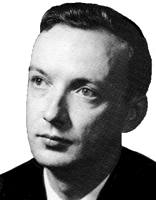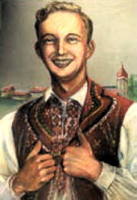
|
The Society of Folk Dance Historians (SFDH)
Costumes
Home |
About |
Encyclopedia | CLICK AN IMAGE TO ENLARGE |

|
We tend to regard a garment as a "costume" if it is outside our familiar, everyday experience in terms of time and space. Costumes are what actors and actresses wear on stage and what children wear on Halloween. What our parents and grandparents called a "party dress" in the 1920s, we now call a "flapper costume," and to those of us who have never worn the work clothes of a Texas ranch hand, the man in the Marlboro ad is wearing a "cowboy costume."
By the same token, we refer to the clothes that people in other countries put on in the morning as "foreign costumes," "peasant costumes," or "folk costumes." However, by placing foreign modes of dress in the same category as theatrical wardrobe or masquerade fantasy, we can easily reinforce other misconceptions we may have about people in other cultures and their lifestyles. Instead of learning to appreciate other people's image of themselves, we run the risk of regarding them as "colorful ethnic natives" rather than human beings whose means of meeting life's basic needs have developed differently from ours.
Using materials close at hand, we humans have always fashioned garments to protect us from the elements, to make ourselves attractive to others, to establish our identity, and to deal with our gods, and each group of us has developed infinitely varied ways to achieve these aims.
Before modern communications swept us into the age of the Global Village, the world's small communities were comparatively isolated and inbred, their culture largely self-contained. A village's cultural dialect often differed from that of the next village not far down the road.
 In Europe, subtle differences in dress – the choice of colors, the knotting of a kerchief, the geometry motifs in a woven stocking – served to distinguish the inhabitants of one village from another. Even within a given village, variations in the tailoring of a pair of trousers or in the style of head wear differentiated the farmer from the miller, or the marriageable maid from the recent bride.
In Europe, subtle differences in dress – the choice of colors, the knotting of a kerchief, the geometry motifs in a woven stocking – served to distinguish the inhabitants of one village from another. Even within a given village, variations in the tailoring of a pair of trousers or in the style of head wear differentiated the farmer from the miller, or the marriageable maid from the recent bride.
At one time, a woman's costume was handmade by the wearer herself. She spun the yarn or thread, colored it with plant dyes, and wove the fabric. Ornamentation, such as pleating, smocking, and embroidery was painstakingly done by hand over long winter evenings. Everyday dress was eminently practical, devoid of needless decoration and suited to the work to be done. For holidays, family rituals, and other festive occasions, there were more special costumes of more costly materials, more highly ornamented, made up of more parts. A girl would spend years before her marriage embroidering not only her wedding costume, but all the clothes she was likely to wear for the rest of her life.
There were few passing fads in those days. Each generation wore essentially the same clothing as the generation before. Change was slow. In the village society, originality and individualism were not highly valued. The goal of the villager in producing a wood carving or a piece of embroidery was to comply with the traditional rules of the art as perfectly as possible. Yet within these boundaries there is sometimes evidence of the creative impulse, in subtle, ethereal interpretations of basic forms – a nuance of color, a finer stitch, a variant motif.
Men's clothing was made by the woman of the household or by local tailors. Eventually, in some areas, tailors also made major parts of women's costumes. Factory-made items came to replace certain pieces, such as ribbons, kerchiefs, aprons or footwear, until the typical village costume became a combination of homemade and store-bought or machine-made components. Although some costume styles and designs date back to pre-Christian times, lack of historical evidence of what rural populations wore makes it difficult to trace the developments that resulted in folk costumes as we know them. In Europe, the age of costumes was effectively ended by World War II.
Today, costumes of any kind are rarely made or worn in Europe. There are only a few parts of Europe such as southern Yugoslavia, where peasant women wear costumes as their daily dress. Almost everywhere, villagers wear so-called "western" clothing: dresses, suits, and jeans. Even at village weddings, the most tenacious of all the old traditional events, the bride usually wears a white gown and veil – sometimes rented from the village photographer – rather than the elaborate marriage costume her grandmother wore.
In Scandinavia, Scotland, Switzerland, and other parts of western Europe, there are national societies whose members, out of nostalgia and regional pride, have had traditional costumes made for them to wear at certain events and patriotic holidays. Performing folk dance groups also wear costumes or replicas of costumes. But with few exceptions, most traditional costumes survive only in ethnographic museums or in the trunks of very old village women whose wish is to be buried in them.
This article is from a leaflet distributed to visitors at an exhibition of the European costume collection of Michael and Mary Ann Herman at Lincoln Center in New York City in 1980. Its author, Dick Crum, a pupil and longtime friend of the Herman's, was active in the folk dance field for over 50 years, as a research scholar, ethnographer, folk dance teacher, and choreographer specializing in the Balkans.
Reprinted from "Costumes" by Richard Crum.
Viltis Magazine, March-April 1995, Alexander P. Durtka, Jr., Editor.
DOCUMENTS
- Clothing, a list.
- Dick Crum, an article.
- Greek Costume, an article.
This page © 2018 by Ron Houston.
Please do not copy any part of this page without including this copyright notice.
Please do not copy small portions out of context.
Please do not copy large portions without permission from Ron Houston.